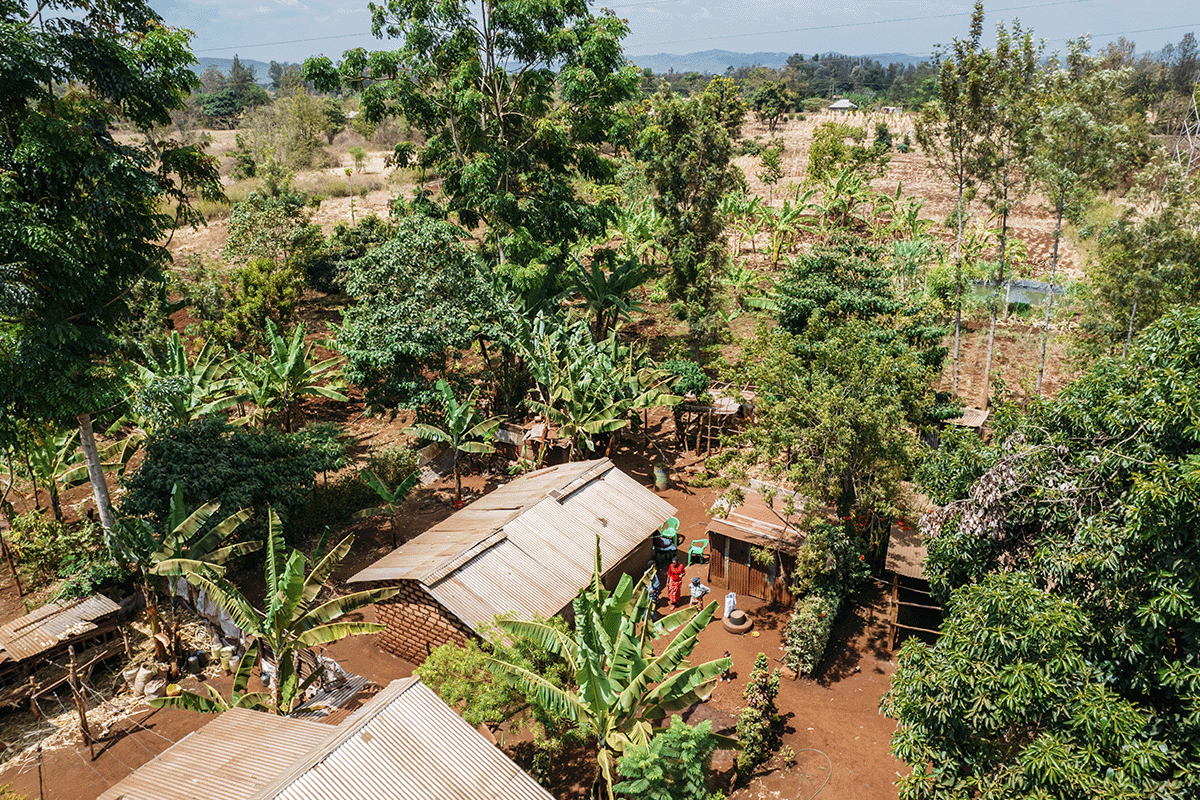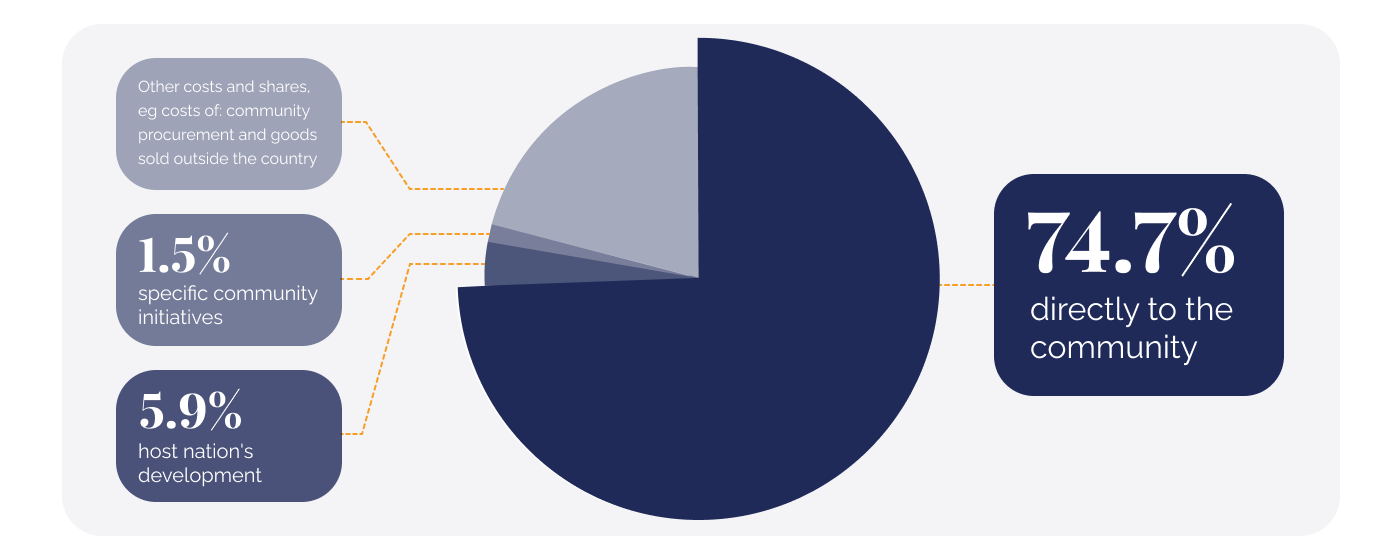Our planet provides a valuable resource vital to all life—forests. Forests, and the trees that form them, produce clean air and water, safeguard wildlife and biodiversity, and prevent soil degradation and desertification. They also act as crucial carbon sinks, storing large amounts of carbon dioxide. Our forests however face continuous threats from deforestation. At DGB Group, we restore forests at scale through our afforestation, reforestation, and agroforestry projects.
 Group of local people and DGB team members with tree seedlings, Hongera Reforestation Project, DGB.
Group of local people and DGB team members with tree seedlings, Hongera Reforestation Project, DGB.
DGB Group’s afforestation and reforestation (A/R) projects
At DGB, our commitment to nature-based solutions is at the heart of everything we do. In our extensive A/R and agroforestry projects across various regions, we plant millions of trees and take pride in the meticulous selection of tree species that contribute to the health of the environment, economically uplift local communities, and create a harmonious balance between nature and socio-economic needs.
Read more: What makes DGB’s reforestation projects unique?
Hongera Reforestation Project, Kenya
Nestled in the heart of Kenya, the Hongera Reforestation Project in Mt Kenya and the Aberdares stands as a testament to our commitment to large-scale nature-based solutions. Focused on areas affected by logging, agriculture, and firewood collection, our mission is to plant over 10 million trees, restore balance to the environment, safeguard biodiversity, and uplift local communities.
Read more: Meet Kenya's green heroes: the team behind the Hongera projects
 Drone photo of a tree nursery, Hongera Reforestation Project, DGB.
Drone photo of a tree nursery, Hongera Reforestation Project, DGB.
Greenzone Reforestation Project, Cameroon
Our Greenzone Reforestation Project in Cameroon's Central Region aims to restore nature, create forests, and promote sustainable development. This initiative is planting more than 16 million indigenous trees to combat deforestation, increase water security, and provide a better quality of life for local communities. This project is the largest registered carbon project in the country and boasts the second-largest tree nursery.
Read more: Greenzone Reforestation Project: cashew trees thriving in our latest planting season
 Tree nursery in Cameroon, Greenzone Reforestation Project, DGB.
Tree nursery in Cameroon, Greenzone Reforestation Project, DGB.
Bulindi Chimpanzee Habitat Restoration Project, Uganda
The Bulindi Chimpanzee Habitat Restoration Project is a vital initiative in the Hoima and Masindi districts of western Uganda that protects the diminishing habitat of over 300 wild chimpanzees. This project aims to restore vital chimpanzee habitats by planting 4.5 million trees to replenish the forest and empower local communities through agroforestry. Our project's unique approach is to work hand-in-hand with local communities and households to find sustainable solutions that benefit both chimpanzees and people.
 Tree nursery in Uganda, Bulindi Chimpanzee Habitat Restoration Project, DGB.
Tree nursery in Uganda, Bulindi Chimpanzee Habitat Restoration Project, DGB.
Our selection of tree species
Our A/R projects plant a diverse array of indigenous fruit trees, nut trees, and shade trees that are adapted to the environment and suit the needs of the local communities. Some species are chosen for their ability to sequester carbon, others for their crop value, which goes directly to local communities. Local communities also receive a fair share of the carbon credit sales and benefit from our projects' long-term positive impacts, such as soil improvement and water security.
 Close-up of a young mango fruit growing on a tree.
Close-up of a young mango fruit growing on a tree.
For those with a particular interest in the species we plant, our current list of species includes (but isn’t limited to):
- Prunus africana: Known for its medicinal properties.
- Cordia africana: A versatile tree providing fodder and traditional medicines, supporting both ecological and economic needs.
- Irvingia gabonensis (African bush mango): A versatile tree with both ecological and economic benefits.
- Persea (haas) (avocado): A popular fruit tree celebrated for its nutritional richness.
- Dacryodes edulis (African pear): Valued for its edible fruits.
- Anacardium occidentale (cashew): A valuable species combining economic benefits with environmental value.
- Macadamia integrifoli (macadamia): A nut tree contributing to sustainable agroforestry.
- Azadirachta indica (neem): Renowned for its medicinal properties.
- Ricinodendron heudelotii: Providing oil-rich seeds and contributing to carbon sequestration.
- Citrus sinensis (orange): Adding a citrusy touch to our projects.
- Chrysophyllum albidum (African apple): A fruit tree with cultural significance.
- Citrus limon (lemon - South Africa variety): Offers fruits while enhancing biodiversity with its unique variety.
- Maesopsis eminii: Known for its fast growth, this tree is a valuable asset in sustainable forestry.
- Albizia coriaria: A multipurpose tree with uses ranging from soil improvement to livestock forage.
- Markhamia lutea: Celebrated for its ornamental value, this tree also provides shade and supports beekeeping, making it a diverse addition to ecosystems.
- Coffea canephora (coffee): Beyond being a cash crop, coffee trees contribute to agroforestry systems, enhancing both economic and ecological sustainability.
- Khaya senegalensis: This tree also offers shade and supports biodiversity, embodying a holistic approach to forestry.
- Forastero cocoa (cocoa): An evergreen tree offering cocoa beans used to make chocolate liquor, cocoa solids, cocoa butter, and chocolate.
 Close-up of a young avocado fruit growing on a tree.
Close-up of a young avocado fruit growing on a tree.
In Uganda, we plant in two zones: the ‘chimp zone’, where we plant chimp-friendly cash crops, like coffee, and the ‘fruit-tree zone’. In both zones we combine fruit and coffee with indigenous tree species. The diverse assortment of species contributes to a healthier and more resilient ecosystem and provides a range of environmental and socio-economic benefits. For example, in our agroforestry system, we mix three fruit species with three indigenous species to have a minimum of six different species per plot to enhance biodiversity.
Read more: Nurturing harmony in Uganda—A Planet Earth III tale of the Bulindi Chimpanzee Project
Our meticulous species selection is guided by five primary considerations—environmental compatibility, availability, carbon sequestration, economic benefits, and biodiversity.
-
Environmental compatibility: We prioritise species that are suitable for the local ecosystem and climatic conditions. This ensures the health and viability of the plants and reduces the need for artificial interventions, thereby contributing to the project's overall sustainability.
-
Availability: The accessibility of quality seeds and saplings is a key consideration. We seek species for which we can reliably source healthy, high-quality planting material.
-
Carbon sequestration: As our projects are funded by generating high-quality, verified carbon credits, we prioritise species with high carbon sequestration capacities.
-
Economic benefits: We select species that also provide economic benefits, such as fruit and nut harvests. These generate the primary income for the communities involved in the project, thereby enhancing local livelihoods, increasing the project's socio-economic impact, and reducing unsustainable pressure on natural forest habitats.
-
Biodiversity: We aim to create a biodiverse mix in the project. A diverse assortment of species contributes to a healthier and more resilient ecosystem and provides various environmental and socio-economic benefits.
 Drone photo of local people's household in Kenya.
Drone photo of local people's household in Kenya.
Enriching communities: a bountiful harvest of prosperity
At the heart of our agroforestry projects lies a commitment to not only restore nature but also empower communities. In these endeavours, the revenue streams are diverse, but the most significant community income is from the fruits and cash crops harvested from our meticulously planted trees.
In fact, the harvest’s value to local farmers far surpasses and is much more vital than the carbon credit revenue generated by our projects. A staggering 74.7% of the crop revenue flows back to the community. Therefore, almost 75% of revenue from fruit and nut trees goes to the community, becoming a vital source of income and sustenance. The large portion of revenue from crops going to the community is therefore a vital aspect of our projects’ impacts. It isn't just about planting trees; it's about planting the seeds of long-term prosperity.
But the impact doesn't end there. We also established a community fund, dedicating 1.5% to initiatives that directly benefit the local community. This will fund community projects in line with Sustainable Development Goals, such as Quality Education, Clean Water, and Affordable and Clean Energy. Our projects are designed to provide support to both the individual participating farmers and their surrounding communities, bolstering the positive long-term impacts of our projects.
 Chart showing crop revenue distribution.
Chart showing crop revenue distribution.
These figures underscore our dedication to creating a sustainable ecosystem where both nature and communities thrive. By enriching the lives of those at the heart of our projects, we ensure that the benefits of reforestation extend far beyond the trees. It's a holistic approach that embodies our commitment to a greener, more prosperous world for all.
 DGB team member providing tree planting training with pupils from a local school.
DGB team member providing tree planting training with pupils from a local school.
Planting trees—nurturing nature, enriching communities
In our journey through DGB’s A/R projects, we discover the profound impact of nature-based projects on our planet and its people. Each project we undertake is a testament to our unwavering commitment to restoring nature, protecting biodiversity, and promoting sustainable development.
Our projects are not merely about planting trees; they are about improving livelihoods and creating resilience and prosperity. They serve as a beacon of restoration in regions affected by deforestation, degradation, and the pressing needs of growing populations.
Our meticulous species selection, guided by five primary considerations, ensures a holistic approach that embodies environmental compatibility, availability, carbon sequestration, economic benefits, and biodiversity. Each tree we plant enriches ecosystems and provides economic benefits to local communities.
Our agroforestry projects are nurturing a healthier, more sustainable future. Join us in this journey of growth, where every tree represents a promise to restore, protect, and enrich the environment and local communities. You can be part of these transformative initiatives too through our carbon credits that support our impactful projects.
Download our carbon credit brochure









